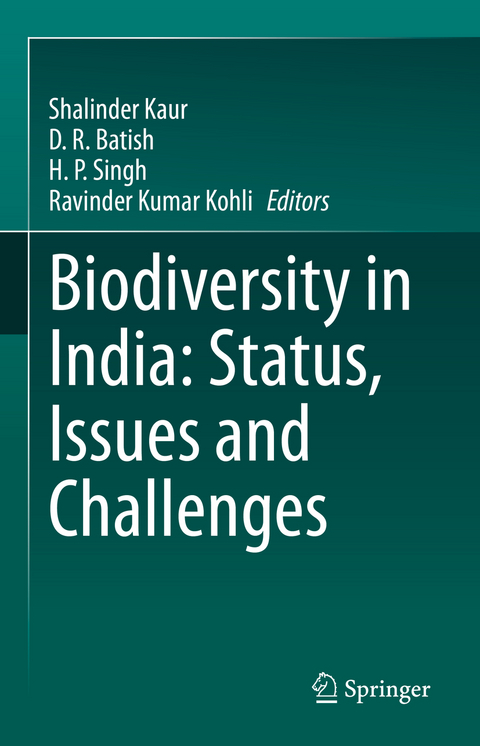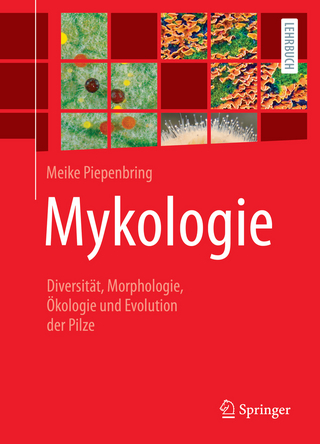
Biodiversity in India: Status, Issues and Challenges
Springer Verlag, Singapore
978-981-16-9776-0 (ISBN)
Shalinder Kaur, Ph.D. is an Assistant Professor in the department of Botany, Panjab University, Chandigarh, India. She is recipient of KK Nanda Gold Medal for Best Thesis in Plant Sciences by Panjab University, and Junior Scientist Award by National Environment Science Academy, India. D.R. Batish, PhD is a Professor, and former Chairperson of the Botany Department at Panjab University, Chandigarh. She has the honour of getting Rajib Goyal Young Scientist Award and University Grants Commission’s Research Award. In addition, she is recipient of V. Puri Memorial Award of Indian Science Congress Association, given to a distinguished scientist of the country and conferred with the fellowship from International Society of Environmental Botanists, Lucknow. She has also served as Visiting Faculty at the Asian Institute of Technology, Thailand twice and is deputy coordinator of IUFRO Working group 8.02.04 on Ecology of Alien Invasive Species. H.P. Singh, PhD is Professor, and former Chairperson of the Department of Environment Studies at Panjab University, Chandigarh. He had been post-doctoral researcher at National Centre for Genetic Engineering and Biotechnology, National Science and Technology Development Agency, Thailand; and visiting faculty at the Asian Institute of Technology, Thailand. He is the recipient of the Shiv Nath Rai Kohli Best Mid-Career Award, Young Scientist Awards by Indian Science Congress Association, Dalela Educational Trust, and Punjab Academy of Sciences. Ravinder Kohli Ph.D., FNA, FASc, FNASc, FNAAS, FPASc, FBS is a certified Emeritus Senior Ecologist ESA, USA. Currently, the Vice-Chancellor of Amity University, Punjab, he is JC Bose National Fellow of the Government of India. Before this, he had been the Vice-chancellor of Central University of Punjab for 6 years and the DUI and Dean Research at Panjab University, Chandigarh. He had been the coordinator of IUFRO Working Group 8.02.04 on Ecology of Alien Invasive Species for 10 years. He is recipient of the Best Scientist Award of the Haryana Government and Punjab Ratan, and was honoured by the Government of UT Chandigarh for teaching and research in Environment. He has guided 53 PhD theses on Ecology and Environment.
Section 1.- Chapter 1. Introduction.- Section 2. Plant Diversity.- Chapter 2. Status, issues and challenges of biodiversity:Lower plants (Non-vascular).- Chapter 3. Status, issues and Challenges of Biodiversity:Higher Plants.- Chapter 4. Status, issues and challenges of biodiversity: Trees and Shrubs.- Chapter 5. Underutilized Plant Strength of India.- Section 3. Faunal Diversity.- Chapter 6. Status, Issues and Challenges of Biodiversity: Invertebrate.- Chapter 7. Diversity, Distribution and Endemicity of Herpetofauna in Different Biogeographic Zones and Biodiversity Hotpots of India.- Chapter 8. Status, Issues, and Challenges of Biodiversity: Wild Animals.- Chapter 9. Indian Avian Diversity:Status, Challenges and Solutions.- Chapter 10. Status, Issues and Challenges of Indian Livestock Biodiversity.- Section 4. Ecosystem Diversity.- Chapter 11. Agricultural Crop Diversity: Status, Challenges and Solutions.- Chapter 12. Biodiversity of Agriculturally Important Insects: Status, Issues and Challenges.- Chapter 13. Biodiversity Issues and Challenges:Non-Agriculture Insects.- Chapter 14. Status, issues and challenges of biodiversity: Forest Insects.- Chapter 15. Status, Issues and Challenges of Biodiversity: Marine Biota.- Chapter 16. Diatoms the living jewels their biodiversity, phycosphere and associated phenotypic plasticity: a lesson to learn from current pandemic of corona virus.- Chapter 17. Plant Diversity at Ecosystems level in India: Dynamics and Status.- Chapter 18. Faunal Diversity at Ecosystems level in India: Dynamics and Status.- Section 5. Challenges and reasons of Biodiversity loss.- Chapter 19. Challenges on Account of Invasive Alien Terrestrial Plants.- Chapter 20. Alien Invasive Aquatic Fauna:Challenges and Mitigation.- Chapter 21. Reasons of Biodiversity Loss in India.- Section 6. Efforts Conservation.- Chapter 22. Conservation of National Biodiversity: Efforts of the Indian Government.- Chapter 23. Legal Framework for Conservation of Biodiversity in India.- Chapter 24. Index.
| Erscheinungsdatum | 21.09.2022 |
|---|---|
| Zusatzinfo | 1 Illustrations, black and white; X, 665 p. 1 illus. |
| Verlagsort | Singapore |
| Sprache | englisch |
| Maße | 155 x 235 mm |
| Themenwelt | Naturwissenschaften ► Biologie ► Botanik |
| Naturwissenschaften ► Biologie ► Ökologie / Naturschutz | |
| Naturwissenschaften ► Biologie ► Zoologie | |
| Schlagworte | Birds • cryptogams • Indian Biodiversity status • Insects • lichens • marine biota • Phanerophytes • threats |
| ISBN-10 | 981-16-9776-0 / 9811697760 |
| ISBN-13 | 978-981-16-9776-0 / 9789811697760 |
| Zustand | Neuware |
| Informationen gemäß Produktsicherheitsverordnung (GPSR) | |
| Haben Sie eine Frage zum Produkt? |
aus dem Bereich


